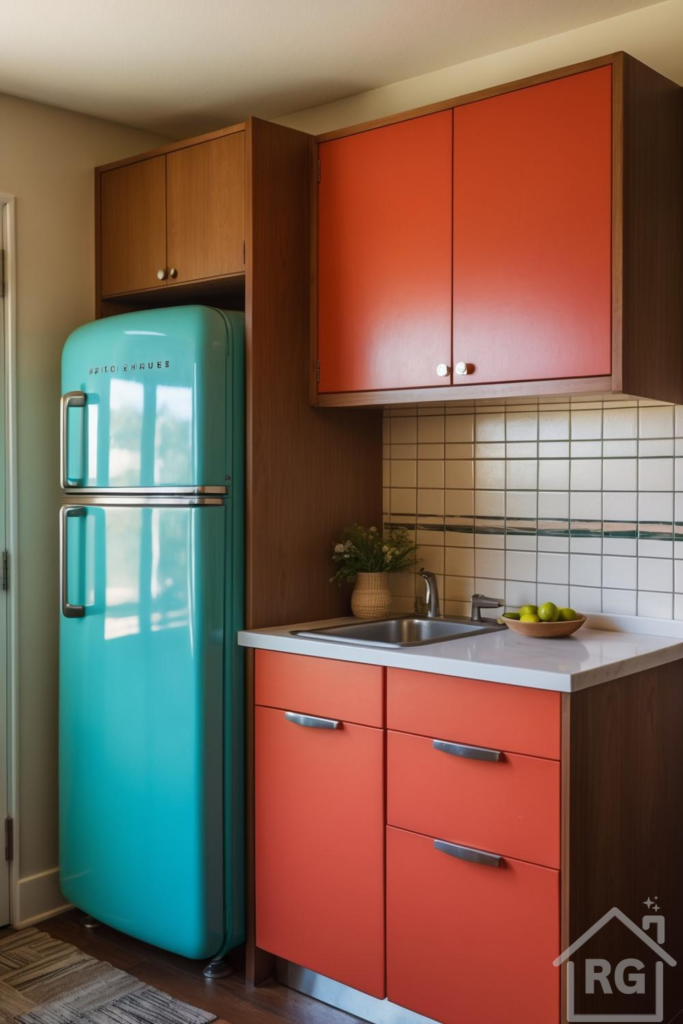
The allure of Mid-Century Modern (MCM) design lies in its optimistic spirit, clean lines, and seamless blend of functionality with organic and geometric forms. This style, flourishing from the mid-1940s to the 1960s, is particularly well-suited for kitchenettes, where efficiency and aesthetics must go hand-in-hand. If you’re captivated by the cheerful energy of a space featuring bold color contrasts, warm wood, and iconic silhouettes, this guide will walk you through achieving a similar look.
1. The Power of Palette: Bold Color Choices
Mid-century design wasn’t shy about color. Forget muted neutrals as the main players; think optimistic and saturated hues. The key is balance.
- Statement Appliance: A retro-style refrigerator in a standout color like turquoise, mint green, pale yellow, or even pink becomes an instant focal point. Brands like Smeg or Big Chill specialize in these, but you can also achieve a similar effect by painting or wrapping an existing modern fridge (ensure you use appliance-specific paint).
- Cabinet Contrast: Pair your statement appliance with contrasting cabinet colors. As seen in the example, a warm, almost persimmon orange creates a dynamic duo with turquoise. Other classic MCM pairings include avocado green with mustard yellow, or teal with walnut.
- Warm Wood Tones: Incorporate natural wood elements to ground the bright colors. Walnut, teak, and oak were popular choices. Use wood for cabinet frames, open shelving, or even countertops (properly sealed, of course).
- Neutral Backdrop: Keep walls and potentially countertops relatively neutral to let the colors pop. Off-white, light grey, or beige provides a clean canvas. A simple, often square, ceramic tile backsplash in white or a pale neutral adds texture without competing visually.
2. Material Matters: Texture and Finish
Texture plays a subtle but crucial role in MCM design.
- Cabinet Finishes: Flat-panel cabinet doors are characteristic of the era. While high-gloss was sometimes used, a smooth matte or satin laminate finish, as seen in the orange cabinets, is very typical and practical.
- Wood Grain: Emphasize the natural beauty of wood. Whether it’s the cabinet surrounds or furniture legs, let the grain show.
- Tile Time: Simple ceramic tiles, often in a square grid pattern, are perfect for backsplashes. Consider a contrasting grout line (like dark grey or black with white tiles) for added definition, or a thin, colored accent tile strip as shown in the image.
- Countertops: Laminate countertops, particularly those mimicking subtle stone patterns or solid colors, were common. Modern quartz in a simple white or light grey also works beautifully and offers greater durability.
- Metals: Chrome and stainless steel were the go-to metals for hardware, faucets, and appliance trim. Look for sleek, simple bar pulls or small, round knobs.
3. Furniture and Fixtures: Iconic Silhouettes
While a kitchenette is primarily about built-ins, the details matter.
- Cabinetry Style: Opt for frameless or partial overlay cabinets with flat-panel doors. This creates the clean, uncluttered look essential to MCM.
- Hardware: Choose minimalist hardware. Sleek, horizontal bar pulls in brushed nickel or chrome are excellent choices. Simple, small knobs can also work.
- Sink & Faucet: An undermount or simple drop-in stainless steel sink maintains clean lines. Pair it with a gooseneck faucet with straightforward handles in chrome.
- Lighting (Implied): Although not fully visible, MCM lighting often features Sputnik chandeliers, globe pendants, or simple recessed lighting. Ensure adequate task lighting under the upper cabinets.
4. Accessorizing the MCM Kitchenette
Accessories are where you can inject personality and reinforce the theme.
- Small Appliances: Look for toasters, kettles, or stand mixers with retro styling or colors that complement your palette.
- Tableware: Melamine dinnerware in bright colors or geometric patterns, ceramic canisters, and simple glassware fit the aesthetic.
- Natural Elements: Bring in greenery with potted plants. Snake plants, spider plants, or small succulents in simple ceramic or woven pots add life.
- Textiles: If space allows for a small rug, choose one with a geometric pattern or a natural fiber like jute. Keep dish towels simple or opt for a retro print.
- Wall Decor: Consider abstract art, a starburst clock, or simple framed prints from the era.
5. Layout and Functionality in Small Spaces
Kitchenettes demand efficiency.
- Vertical Space: Utilize upper cabinets reaching towards the ceiling for maximum storage.
- Smart Storage: Incorporate drawer organizers, pull-out shelves, and tiered shelving within cabinets.
- Clear Countertops: Keep countertops as clear as possible to maintain the uncluttered MCM look and maximize workspace.
- Workflow: Arrange the fridge, sink, and primary workspace (countertop) in a logical flow, even in a compact area.
Bringing it All Together
Designing a mid-century modern kitchenette is about capturing a feeling – one of optimism, simplicity, and stylish functionality. Start with a bold color decision, balance it with warm wood and neutral surfaces, choose materials and hardware authentic to the era, and keep the lines clean. By focusing on these key elements, you can create a small but mighty kitchen space that is both a joy to look at and a pleasure to use. Don’t be afraid to mix vintage finds with modern reproductions to achieve the perfect blend for your home.
